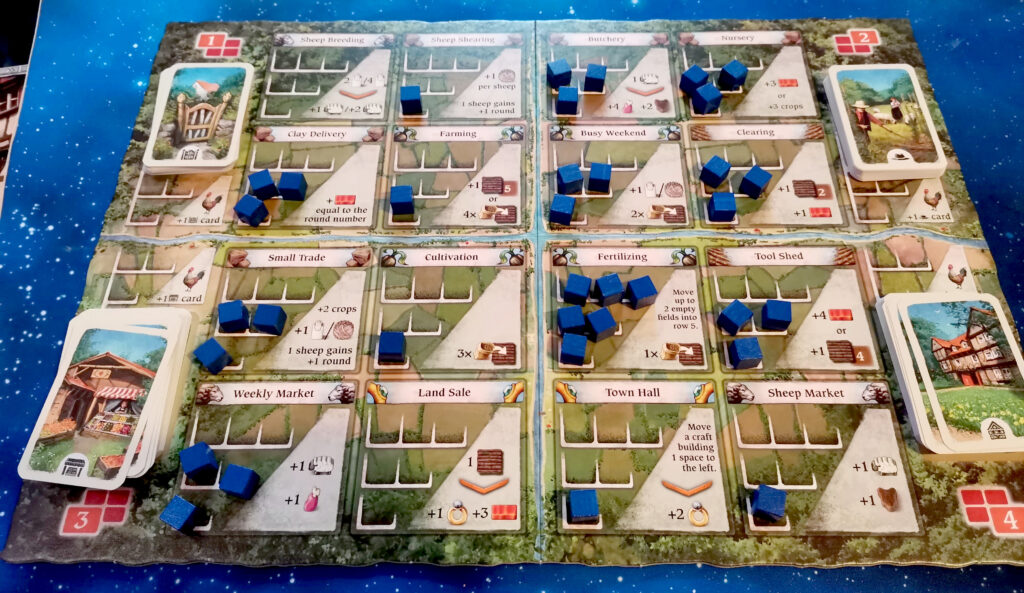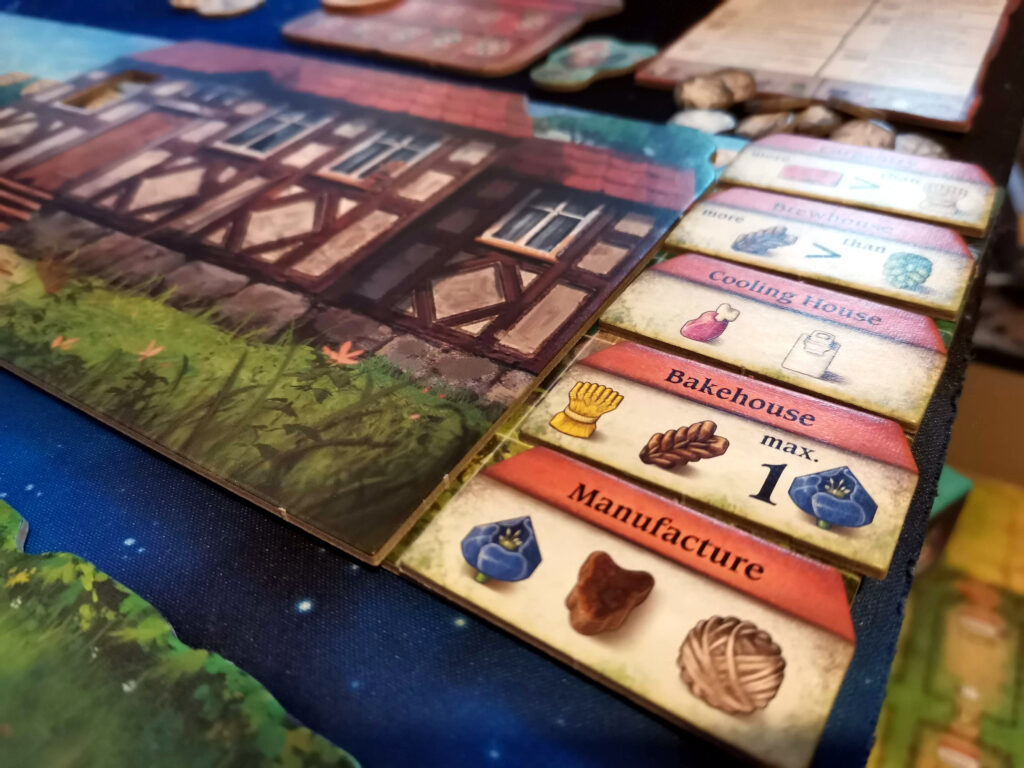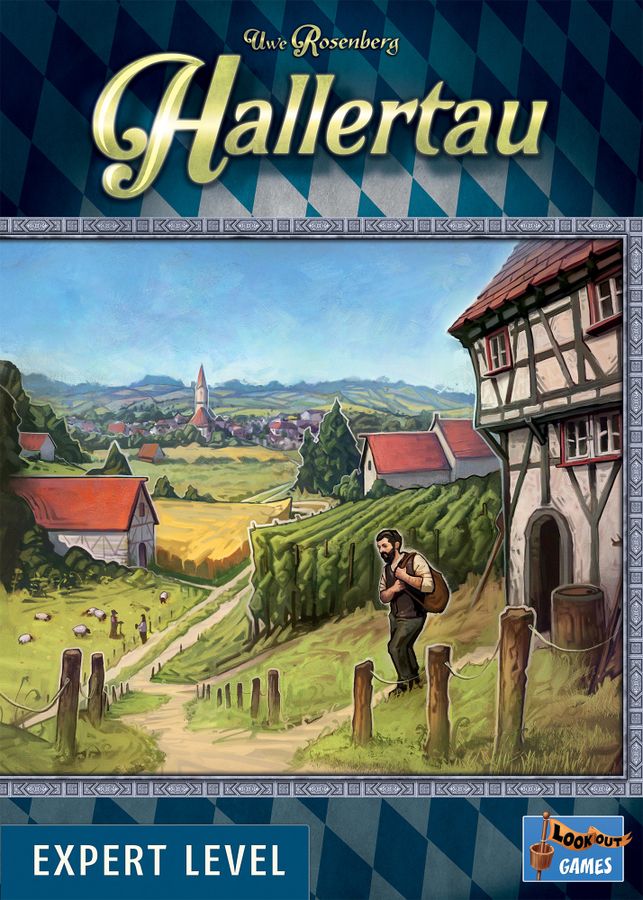Buckle up folks, we’re going hop-growing in Bavaria! Hallertau is the longest continuous hop-producing region in the world, and in this medium-heavy game from Uwe Rosenberg, we’re going back to 1850 to develop our Bavarian villages and try to be the biggest and best.
If, like me, you’re a fan of Uwe Rosenberg, you probably find yourself getting excited whenever he announces a new game based on a geographical region. He has some serious form when it comes to Euro games based in real places. Le Havre, Glass Road, Nusfjord, Fields of Arle, Reykholt – not a stinker among them. Hallertau is the latest to continue in this vain, and it’s good.
Cubes, cubes, cubes
You won’t be remotely surprised to learn that Hallertau is a worker-placement game. Uwe is a master of the form, so it’s reassuring to know. Instead of placing meeples or discs though, this time we’re placing little blue cubes as workers. The basic gameplay is what you might expect – place workers in turn order, take them back, get some resources. If you’re the first player to a spot it costs you one worker, the second player uses two, the third has to expend three workers. It’s what you do with those resources where Hallertau gets clever.

Each player has a board which represents their land. Field tiles can be added to the land, into which you can sow your crops. Plant rye in a level three field, you get three rye – who’d have thought. As in real life though, the soil there is not as good to grow crops in again straight away, so the field slides down a level, and would only yield two the next time, and so on. However, if you don’t plant for a season and leave the field fallow, its potency goes up a level. Balancing when to sow and when to leave a field alone is key to getting enough resources to do well in the game.
But what does doing well in Hallertau look like? What are you trying to do in order to score those elusive VPs?
Moving house
Each player has a long board with a large, cardboard, community centre building tile on it. Next to it are five craft building tiles, and by using your resources you can improve them and slide them to the right. Once each building has moved along, the big community centre can slide along behind them and fill in the spaces.

Now I know as well as anyone that Euro games don’t always have the tightest theme integrations. So you might be reading that paragraph above and thinking “Hang on, why are we moving entire buildings in 19th century Germany?!“, and It’s a fair question. Underneath the big community centre there’s a nice view of your village. By doing well and uncovering it, you’re increasing the visibility – both figuratively and literally – of your village. Clever eh?
Adaptive puzzling
Hallertau does what all the best Uwe Rosenberg games do. It offers up an efficiency puzzle, one which should always be possible to complete, but there are so many variables thrown your way that solving that puzzle is hard. On the four corners of the main board there are four decks of cards. The bonus and points decks are the same every game, but for both the farmyard and gateway cards there are four different decks of each in the box. Some cards give you short-term rewards for collecting and spending certain things, while others can give you big points if you can factor in their demands while still playing the main game. That’s a lot of variety right there.
Moving the craft buildings needs efficiency and planning too. For each of the six rounds in the game, the number of resources you need to spend to move each building is the same as the round number. Each has a constraint too; for example the brewhouse states that you must spend more barley than hops. In round one, you can move it with just one barley, as you meet that constraint – you paid more barley than hops. In later rounds you get a discount for paying with multiple resource types, and it means that some rounds are more efficient to move buildings in than others. Plan ahead, farmers.
Function over theme?
It’s a Euro, so there’s always going to be that bias towards the mechanisms of the game over the theme. That said, however, Uwe Rosenberg is one of the few Euro designers who really takes theme to heart in his games, and it’s evident all through Hallertau. Yes, the “making your village more visible in the eyes of the world” is stretching things a bit, but everywhere else the theme is solid.
Sheep age, and die. If you can look after them long enough, they’ll give you milk in each production round, but you might want to shear them for wool, or send them to slaughter for the meat. The field rotation mechanism, and fallow fields improving, while over-farmed ones get worse, is inspired. It’s not just a ‘solve this puzzle’ for the sake of it, it’s real-world consideration.

There’s a part of me that worries the puzzle of moving the community centre all the way to the end is solvable. That’s where the big points lie, if you can complete that movement. I haven’t solved it yet, to the point where I can look at the boards and think “Yes, I know exactly what I need to do here“. If that does happen, then I worry a little about whether it becomes a battle of who can manage to complete the most scoring cards, while we all finish the community centre. There feels like there’s maybe too much dependency on that central aim to get a good score, compared to something like Nusfjord or A Feast For Odin, where there are so many ways to win.
Mind you, some people really like that focus, so maybe that’s what would swing Hallertau for you, ahead of any of his other games.
Solo play
Solo players rejoice. Hallertau is another Rosenberg game like Nusfjord, where you chase your best score, and your workers for the previous rounds may block you in later ones. A card is flipped each round which tells you which quadrant of the board to remove the top rows of workers from, but for the rest of the worker spaces there are likely to be workers blocking the cheap spaces. That’s the biggest difference between this and his other games, you’re almost never completely blocked from a space, it’ll just cost you more workers to take the action.
Solo play, spending, and scoring is all identical to playing the multiplayer game, so if you’re happy with a good beat-your-own-score mode, Hallertau is a great option.
Final thoughts
I’ve gushed over Uwe Rosenberg in this review, I realise that. But it’s not just rampant fanboyism, it’s deserved. The genius in his games comes in hiding a very deep, complex game underneath some really simple rules. You don’t have pages and pages of rules and conditions in Hallertau to work your way through. If you have enough blue cubes to fill a space, you can get the thing it gives you. If you can afford the resources to move a craft building, you can move it. That simplicity frees your brain up for the much less-simple task of figuring out which of those worker spaces are going to ultimately give you the resources you need to move those buildings.
That simplicity in design carries over into the rule book. By splitting every round into 10 discrete phases, there’s no ambiguity, and each of those phases is simple in its execution. I can honestly say that other than for setup if I haven’t played in a while, or checking the details of a card in the (excellent) glossary, I haven’t needed the rule book after my first game. Hallertau has a community-voted 3.30/5 weight on BGG at the time of writing, how many of your games at a similar weight can you say you never need the rule book for? The included player aids are excellent and double-sided: one side with symbols, the other with short explanations.
As I mentioned above, my only real worry is around how solvable the community centre puzzle may be. Other than that, there’s nothing I don’t like about Hallertau. It’s a fantastic worker-placement game with a unique way of handling agriculture, huge variety in cards, and great component quality. If you’re a Rosenberg fan it’s a must-have, and different enough from his previous games to warrant shelf space. A proper, old-school Euro about farming in historical Europe, I love it.

Designer: Uwe Rosenberg
Publisher: Lookout Games
Art: Lukas Siegmon, Klemens Franz
Players: 1-4
Playing time: 60-120 minutes
